The AMD Radeon R9 290X Review
by Ryan Smith on October 24, 2013 12:01 AM EST- Posted in
- GPUs
- AMD
- Radeon
- Hawaii
- Radeon 200
GRID 2
The final game in our benchmark suite is also our racing entry, Codemasters’ GRID 2. Codemasters continues to set the bar for graphical fidelity in racing games, and with GRID 2 they’ve gone back to racing on the pavement, bringing to life cities and highways alike. Based on their in-house EGO engine, GRID 2 includes a DirectCompute based advanced lighting system in its highest quality settings, which incurs a significant performance penalty but does a good job of emulating more realistic lighting within the game world.
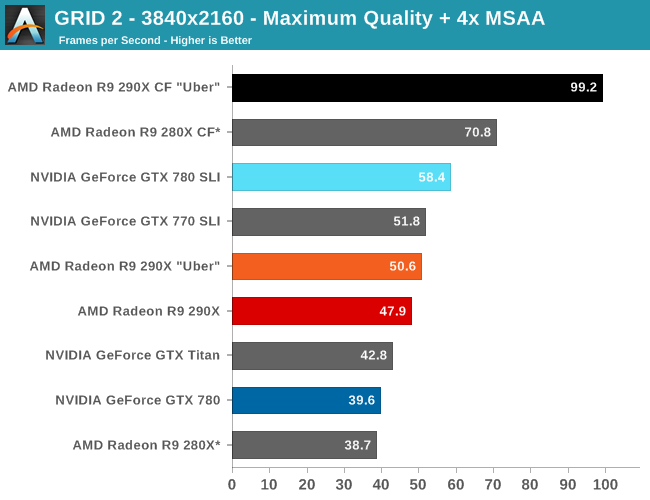
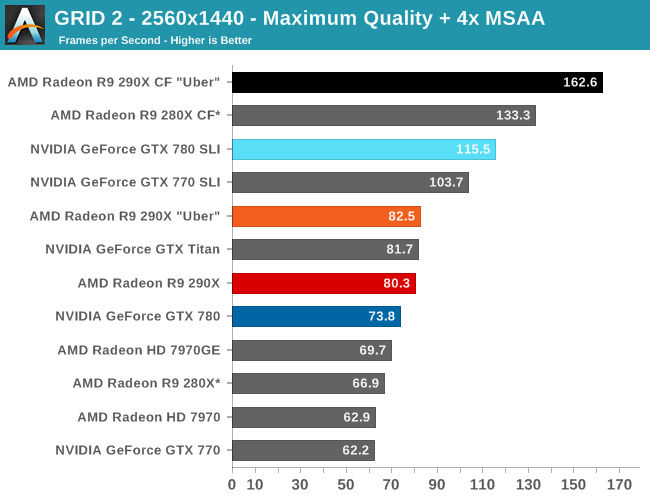
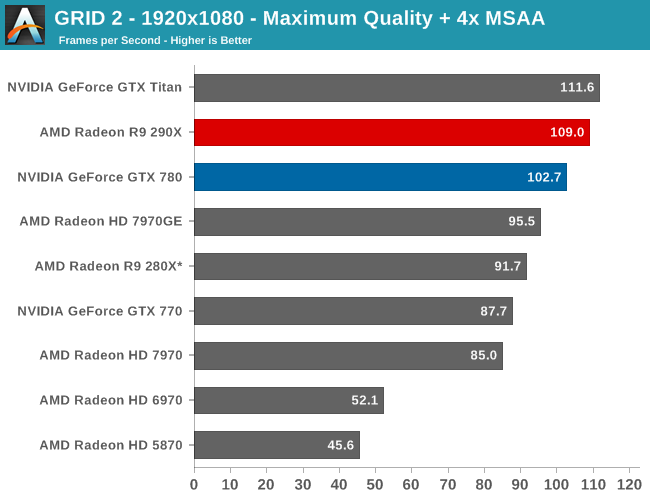
For as good looking as GRID 2 is, it continues to surprise us just how easy it is to run with everything cranked up, even the DirectCompute lighting system and MSAA (Forward Rendering for the win!). At 2560 the 290X has the performance advantage by 9%, but we are getting somewhat academic since it’s 80fps versus 74fps, placing both well above 60fps. Though 120Hz gamers may still find the gap of interest.
Moving up to 4K, we can still keep everything turned up including the MSAA, while pulling off respectable single-GPU framerates and great multi-GPU framerates. To no surprise at this point, the 290X further extends its lead at 4K to 21%, but as usually is the case you really want two GPUs here to get the best framerates. In which case the 290X CF is the runaway winner, achieving a scaling factor of 96% at 4K versus NVIDIA’s 47%, and 97% versus 57% at 2560. This means the GTX 780 SLI is going to fall just short of 60fps once more at 4K, leaving the 290X CF alone at 99fps.
Unfortunately for AMD their drivers coupled with GRID 2 currently blows a gasket when trying to use 4K @ 60Hz, as GRID 2 immediately crashes when trying to load with 4K/Eyefinity enabled. We can still test at 30Hz, but those stellar 4K framerates aren’t going to be usable for gaming until AMD and Codemasters get that bug sorted out.
Finally, it’s interesting to note that for the 290X this is the game where it gains the least on the 280X. The 290X performance advantage here is just 20%, 5% lower than any other game and 10% lower than the average. The framerates at 2560 are high enough that this isn’t quite as important as in other games, but it does show that the 290X isn’t always going to maintain that 30% lead over its predecessor.
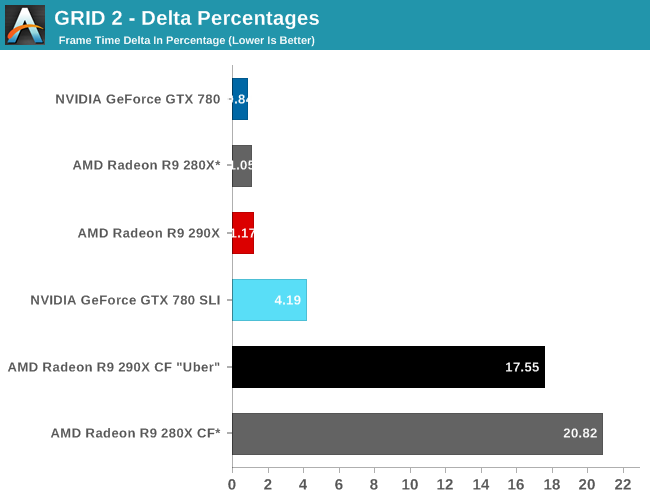
Without any capturable 4K FCAT frametimes, we’re left with the delta percentages at 2560, which more so than any other game are simply not in AMD’s favor. The GTX 780 SLI is extremely consistent here, to the point of being almost absurdly so for a multi-GPU setup. 4% is the kind of variance we expect to find with a single-GPU setup, not something incorporating multiple GPUs. AMD on the other hand, though improving over the 280X by a few percent, is merely adequate at 17%. The low frame times will further reduce the real world impact of the difference between the GTX 780 SLI and 290X CF here, but this is another game AMD could stand some improvements, even if it costs AMD some of the 290X’s very strong CF scaling factor.


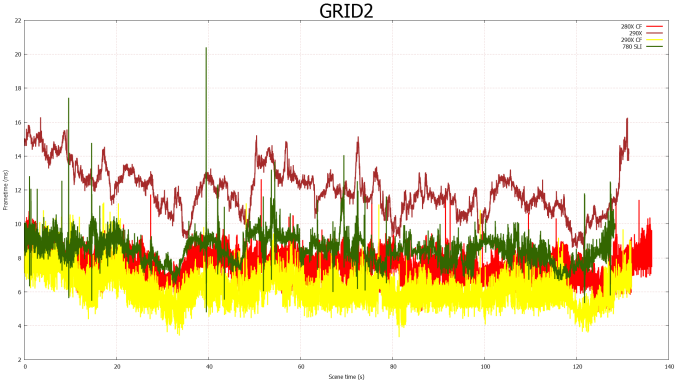








396 Comments
View All Comments
heflys - Thursday, October 24, 2013 - link
Slightly slower than a 780 overall? Even in Uber mode? Can you link me to these reviews if possible?Shark321 - Thursday, October 24, 2013 - link
I didn't say that. It's slightly slower in Uber Mode than Titan overall in 1080p (across all sites combined). In Quiet mode it's usually slightly faster than 780, slighttly slower in the minority of the reviews.heflys - Thursday, October 24, 2013 - link
I see now.Jumangi - Thursday, October 24, 2013 - link
What noob would buy a 290x or a Titan and run it in 1080p? A pointless resolution for these cards.
inighthawki - Thursday, October 24, 2013 - link
What an arrogant post. There are tons of people who game on 1080p displays and buy a 290X or a Titan. Having a high framerate (i.e. consistently greater than 60fps) reduces the likelihood of stuttering while playing, while also making your system a bit more future-proof as new games come out. Not everyone cares about pixel count, some care more about quality per pixel. As you start seeing titles ship on Unreal 4, post-Crysis 3, etc, I will be laughing at you when I can still run my games at native resolution without the need to upscale or reduce quality.puppies - Saturday, October 26, 2013 - link
Anyone who buys a titan to play games at 1080p is insane, seriously they need locking up. You claiming otherwise does nothing.Samus - Thursday, October 24, 2013 - link
agreed. this card is for 2560x1440+ or multimonitorTheJian - Friday, October 25, 2013 - link
ROFL...Only if you don't believe in MAXING your games. Which nobody can do with a single card. Many sites comment on this, and show mins, even here with lower settings they hit below 30fps in a few of their games at 2560. In multiplayer you'd get crushed by guys hitting much higher fps at 1080p in many games. Maybe you'll be right at 20nm, but certainly there are far too many games you have to jockey settings around on to make you right today.reddev - Thursday, October 24, 2013 - link
Both LinusTechTips and OC3D, two reviewers I trust quite a bit, have it below the 780.randomhkkid - Friday, October 25, 2013 - link
Linus tech tips over clocks all the cards it tests, since the 780 has much more headroom (on the stick cooler) the gains were larger than the 290x so at stock the 290x is faster.